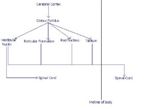Motor Pathways - Anatomy & Physiology
Introduction
Motor pathways carry signals from the brain to skeletal muscle and smooth muscle such as those contained in glands. The system consists of upper and lower motor neurones. The information provided below is primarily focussed on the motor pathways that coordinate skeletal muscle movement, i.e. motor pathways related to voluntary control of skeletal muscles.
Motor Pathways
The connections between the motor cortex in the forebrain and motor neurons within the spinal cord are made up of two pyramidal tracts; the pyramidal system and the extrapyramidal system. These motor pathways are transmitted via the ventral horns within the spine. Upper motor neurones are located mainly within the neopallium of the cerebellum. They govern the excitation or inhibition of lower motor neurones.
Stimulation of the motor neurons is as a result of activity within the cerebral cortex and/or thalamus. There is a balance between the excitatory and inhibitory inputs from these parts of the brain. The thalamus effectively acts as a relay station from the cerebrum and cerebellum before neurons lead into the motor pathways of the spine.
Pyramidal System (Corticospinal)
The pyramidal tract produces fine movements associated with skill, e.g. writing and playing a musical instrument in humans. This tract is composed of direct connections that contain no synapses within the brain stem. Nerve fibres of the pyramidal system originate in the cerebral cortex and then pass to the thalamus, and medulla oblongata. Therefore the neurons pass directly through the ventral aspect of the medulla oblongata in a pyramidal shape providing the reason for the name of this tract. Some fibres decussate in the medulla oblongata, whilst others remain ipsilateral until they leave the spinal cord where they cross the midline of the body. The result of this is that all fibres cross the midline at some point, so that the left side of the brain controls the right side of the body and vice versa.
Motor tracts within the pyramidal system are fundamental in the control and coordination of muscle groups that require concentration and conscious thought to control. This is particularly true for movements of the hands and fingers and therefore these pyramidal tracts are most developed in primates, although may exist in other species such as the cat, where they aid in grooming. It is thought that the evolution of pyramidal tracts is closely associated with the development of conscious and fine movements. In most domestic species that lack the ability to undertake fine movements the pyramidal tracts are primarily involved in control of the jaw, lips and aspects of the face.
Extrapyramidal System
The extrapyramidal system represents part of the motor pathway system that has synapses within the brain stem which is in contrast to those of the pyramidal system. The extrapyramidal tract is distinguishable from the pyramidal system as tracts do not run within the pyramids of the medulla oblongata and instead run outside. This extrapyramidal pathway contains various multisynaptic pathways that relay within several nuclei in the brain. These nuclei are dispersed from the telencephalon to the medulla oblongata and may be visible grossly.
Other parts of the extrapyramidal tract take origin from the tectum and reticular formation. These synapses within the brain stem make it possible for the motor neurone signals to be influenced as they enter the ventral horn of the spinal cord. The cerebellum utilises this influence to ensure that movements are smooth and coordinated.
There are a number of neurones involved in modifying the neuronal signals in the extrapyramidal tract. These include the neurones that relay within nuclei which include the red nucleus, the substantia nigra, the caudate nucleus, the subthalamic nuclei and the olive in the medulla oblongata. The reticular formation is also involved in the extrapyramidal pathway. Neurones that relay in the red nucleus and reticular formation relay directly onto lower motor neurons whilst others relay to other nuclei. The main descending motor tracts from the red nucleus and the reticular formation are the rubrospinal tract, the reticospinal tract, the vestibulospinal tract and the tectospinal tract. The rubrospinal tract is important in carnivores and ungulates as it modulates pattern generators in the spinal cord.
The extrapyramidal tract is responsible for the control of larger muscles and also groups of muscles. This tract constitutes a major part of the coordination system in which groups of muscles are used to maintain posture and smooth movements during locomotion. These types of movements do not require the same level of conscious input or concentration as those of the pyramidal tract. It is thought that the extrapyramidal system represents an earlier evolutionary development than the pyramidal system and therefore is more often a feature of animals less able to perform complex movements. It is the most important system in domestic species.
Links
| This article has been peer reviewed but is awaiting expert review. If you would like to help with this, please see more information about expert reviewing. |
Error in widget FBRecommend: unable to write file /var/www/wikivet.net/extensions/Widgets/compiled_templates/wrt673f72ad8ac3f2_47554037 Error in widget google+: unable to write file /var/www/wikivet.net/extensions/Widgets/compiled_templates/wrt673f72ad95a148_11582397 Error in widget TwitterTweet: unable to write file /var/www/wikivet.net/extensions/Widgets/compiled_templates/wrt673f72ad9c4c10_57378770
|
| WikiVet® Introduction - Help WikiVet - Report a Problem |


